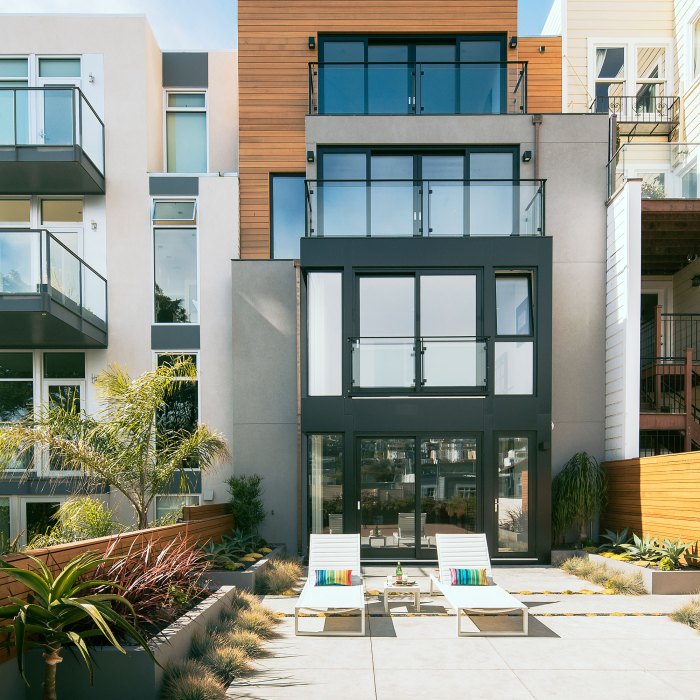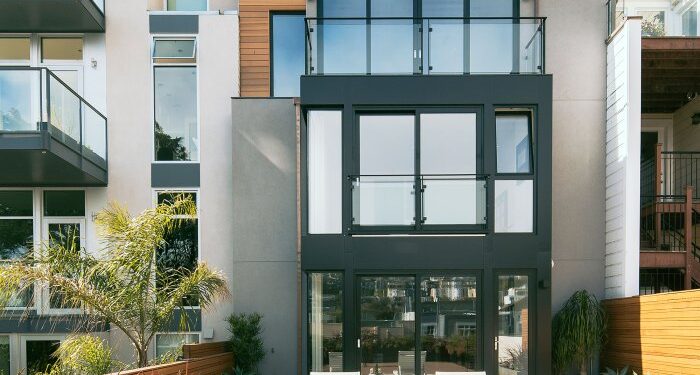Embark on a journey into the world of energy efficient home exteriors, where innovative design meets sustainability to create spaces that are both eco-friendly and cost-effective. Explore the key elements and benefits that make these exteriors a smart choice for modern homeowners.
Importance of Energy Efficient Home Exteriors
Having energy efficient home exteriors is crucial for various reasons, including:
Lower Energy Bills
- Proper insulation in walls, roofs, and windows helps maintain consistent indoor temperatures, reducing the need for heating and cooling systems to work overtime.
- Energy efficient exteriors minimize air leaks, preventing energy loss and ultimately leading to lower utility bills.
- Using energy-efficient materials such as insulated siding and energy-efficient windows can significantly reduce energy consumption.
Key Features of Energy Efficient Home Exteriors
- High-quality insulation to prevent heat loss in winter and heat gain in summer.
- Energy-efficient windows with low-E coatings and multiple panes to minimize heat transfer.
- Proper sealing and weather-stripping to prevent air leaks and drafts.
- Reflective roofing materials to reduce heat absorption and keep the home cool.
Materials for Energy Efficient Home Exteriors
When it comes to creating energy efficient home exteriors, choosing the right materials is crucial. Different materials offer varying levels of energy efficiency, durability, and maintenance requirements. Let's explore some of the options available:
Insulated Siding
Insulated siding is a popular choice for energy efficient exteriors. It helps to minimize heat loss in the winter and heat gain in the summer, reducing the need for heating and cooling. This material is durable and requires minimal maintenance, making it a cost-effective option in the long run.
Low-E Windows
Low-E (low emissivity) windows are another key component of energy efficient home exteriors. These windows have a special coating that reflects heat back to its source, helping to maintain a consistent indoor temperature. Low-E windows are effective in reducing energy consumption and can contribute to overall energy savings.
Cool Roofs
Cool roofs are designed to reflect sunlight and absorb less heat compared to traditional roofs. By keeping the roof surface cooler, cool roofs help reduce the amount of heat transferred into the home, thus lowering the need for air conditioning.
These roofs can also extend the lifespan of the roof by reducing thermal stress.
Design Elements for Energy Efficiency
When it comes to optimizing energy efficiency in home exteriors, there are several design elements to consider. From landscaping choices to window placement, each detail plays a crucial role in reducing energy consumption and creating a comfortable living environment.
Landscaping for Energy Efficiency
Landscaping can significantly impact the energy efficiency of a home. By strategically planting trees and shrubs, you can provide natural shade during hot summer months, reducing the need for air conditioning. Additionally, proper landscaping can act as a windbreak, protecting your home from harsh winds and lowering heating costs in the winter.
Window Placement and Shading
The placement and shading of windows are essential factors in energy efficient design. South-facing windows receive the most sunlight throughout the day, so it's crucial to have shading elements such as awnings, blinds, or trees to prevent overheating in the summer.
On the other hand, north-facing windows receive less direct sunlight and can be used for natural lighting without causing excessive heat gain.
Innovative Technologies for Energy Efficient Exteriors

Smart technologies play a crucial role in enhancing energy efficiency in home exteriors. By integrating advanced solutions such as solar panels, energy-efficient lighting, and innovative insulation techniques, homeowners can significantly reduce energy consumption and lower utility costs.
Integration of Solar Panels and Energy-Efficient Lighting
The integration of solar panels in home exteriors allows homeowners to harness renewable energy from the sun, reducing reliance on traditional electricity sources. These panels convert sunlight into electricity, providing a sustainable and cost-effective power source for various household needs.
Additionally, energy-efficient lighting fixtures, such as LED lights, consume less energy while providing adequate illumination, further contributing to overall energy savings.
Impact of Advanced Insulation Techniques
Advanced insulation techniques, such as spray foam insulation, insulated siding, and energy-efficient windows, play a vital role in minimizing heat loss and maintaining a comfortable indoor temperature. By preventing air leaks and improving thermal efficiency, these technologies help reduce the workload on heating and cooling systems, leading to lower energy consumption and increased savings on utility bills.
Final Thoughts
In conclusion, energy efficient home exteriors offer a harmonious blend of functionality, style, and environmental consciousness. By implementing the right materials, design elements, and technologies, homeowners can transform their houses into efficient and sustainable living spaces.
Quick FAQs
How do energy efficient home exteriors contribute to lower energy bills?
Energy efficient home exteriors help reduce heat transfer, keeping the interior of the house at a stable temperature and minimizing the need for heating or cooling appliances, resulting in lower energy consumption.
What are some key features of energy efficient home exteriors?
Key features include proper insulation, energy-efficient windows, reflective roofing materials, and smart technologies like programmable thermostats and solar panels.
How can landscaping contribute to energy efficiency in home exteriors?
Strategic placement of trees and shrubs can provide natural shade, reduce heat absorption by the house, and improve air circulation, all of which contribute to energy savings.










